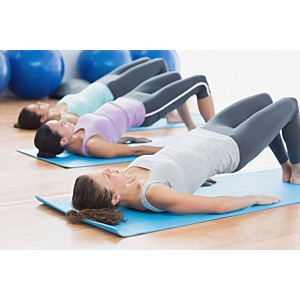How to Lose Weight Whilst Maintaining a Healthy Pelvic Floor
The majority of us would probably consider health and fitness as a top priority. But, sometimes this is not achievable, especially when improving one aspect of your health results in the weakening of another.
Nowadays, the appearance that looks back at us in the mirror is the only one we care about, but it’s vital that we remember to give a little TLC and maintenance to our inner health as well!
High impact exercise and fitness trends can deteriorate your pelvic health. But, this does not mean that you can’t lose any weight at all! Read on to learn some top tips for losing weight whilst maintaining a strong and healthy pelvic floor.
What’s the Link Between Weight and the Pelvic Floor?
Obesity is associated with an increased risk of incontinence-related conditions, e.g. type 2 diabetes mellitus and osteoarthritis associated with poor mobility. Urinary bladder pressure is greater in people who are obese than those who are not.
The National Institute for Health & Care Excellence (NICE) specifies that women with a body mass index (BMI) of 30+, as well as suffering from urinary incontinence or overactive bladder, should be advised to lose weight. People who have a BMI of 30+ are classified as clinically obese.
However, a multitude of studies have found that a 5-10% weight loss for overweight women will result in a huge improvement in urinary incontinence symptoms.
Top Tips on Weight Loss for a Healthier Pelvic Floor
- Kegel! – Whilst performing your usual fitness regime, try adding in a few Kegel exercises to support and strengthen your pelvic floor.
- Abolish alcohol – Failing that, try to reduce your intake. Some alcohol can be high in calories, and it is also a diuretic that can increase your urine production, making overactive bladder symptoms even worse!
- Curb the caffeine – Caffeine itself isn’t particularly high in calories, however the fancy drinks we order, like Frappuccino’s and lattes can raise those numbers. It’s also a diuretic, just like alcohol, so try and manage your intake.
- Ditch the fizzy drinks – Carbonated drinks can really irritate your bladder, so it’s best to cut back on them if you can. Your bladder loves being hydrated with a few cups of simple water alone, plus water has no calories – win-win!
- Stop the strain – Avoid exercises that have the capability to strain your pelvic floor. Read on to learn the best exercises for pelvic floor health and safety.
- Mix it up – Varying the type of exercise you do can help promote weight loss but remember to choose low impact exercise – your pelvic floor will thank you.
- Fat focus – When standing, your abdominal (visceral) fat combines with gravity to create a downward pressure on your pelvic floor. This weight can strain your pelvic floor muscles and worsen any dysfunctions, such as prolapse.
What are the Best Exercises for Weight Loss and Pelvic Floor Protection?
- Swimming – Breast stroke is one of the best forms of swimming to burn energy and lose weight whilst also being a low impact exercise for your pelvic floor.
- Pilates – Pilates is a mat-based exercise that targets deep postural muscles in your abdomen, spine and pelvic floor to improve your overall central core stability and posture. This structured and carefully performed exercise is a lot safer for your pelvic floor than frantic jumping and activities where you have to run around.

Which Exercises Should Be Avoided to Protect Your Pelvic Floor?
- Cardio – If the exercises you choose to do includes running or jumping, the pressure you exert onto your pelvic floor can lead to serious damage in the form of a pelvic floor disorder. Women’s Health Physiotherapist, Emma Brockwell, has said that ground reaction force in running is thought to be between 2.5 to 3 times your body weight, so your body has to be able to manage this load.
- Weight lifting – Lifting heavy objects can be detrimental to your pelvic health, due to the huge amount of pressure that is forced onto the muscles. However, if weight lifting is part of your routine, try performing a Kegel whenever you lift to support your pelvic floor.
Sources
[1] Kenway, M. (2014) The Best Exercise for Weight Loss that Avoids Prolapse Worsening [online]. Pelvic Exercises [viewed 20/11/2018]. Available fromhttps://www.pelvicexercises.com.au/best-exercise-for-weight-loss/
[2] Montague, H. (2018) Optimising weight loss advice in obese women with urinary incontinence: a review. Urology News, 23(1):18-20.
[3] NICE (2015) Urinary Incontinence in Women: Management [online]. National Institute of Health and Care Excellence [viewed 20/11/2018]. Available from https://www.nice.org.uk/guidance/cg171
[4] Noblett, K.L., Jensen, J.K., Ostergard, D.R. (1997) The relationship of body mass index to intra-abdominal pressure as measured by multichannel cystometry. Int Urogynaecol J, 8(6):323-326.
[5] Parker-Autry, C.Y., Subak, L.L., Creasman, J. et al. (2013) Urodynamic changes associated with weight loss in overweight and obese women with urinary incontinence. Female Pelvic Medicine and Reconstructive Surgery, 19(117):610-617.
[6] PhysioPilates Academy (2018) About Pilates [online]. PhysioPilates Academy [viewed 20/11/2018]. Available from https://www.physiopilatesacademy.co.uk/about-physiopilates/
[7] Public Health England (2016) Health Risks of Adult Obesity [online]. PHE [viewed 20/11/2018]. Available from https://webarchive.nationalarchives.gov.uk/20170110171059tf_/https://www.noo.org.uk/NOO_about_obesity/obesity_and_health/health_risk_adult
[8] Vissers, D., Neels, H., Verdandel, A. et al. (2014) The effect of non-surgical weight loss intervention on urinary incontinence in overweight women: a systematic review and met-analysis. Obes Rev, 15(7):610-617.

